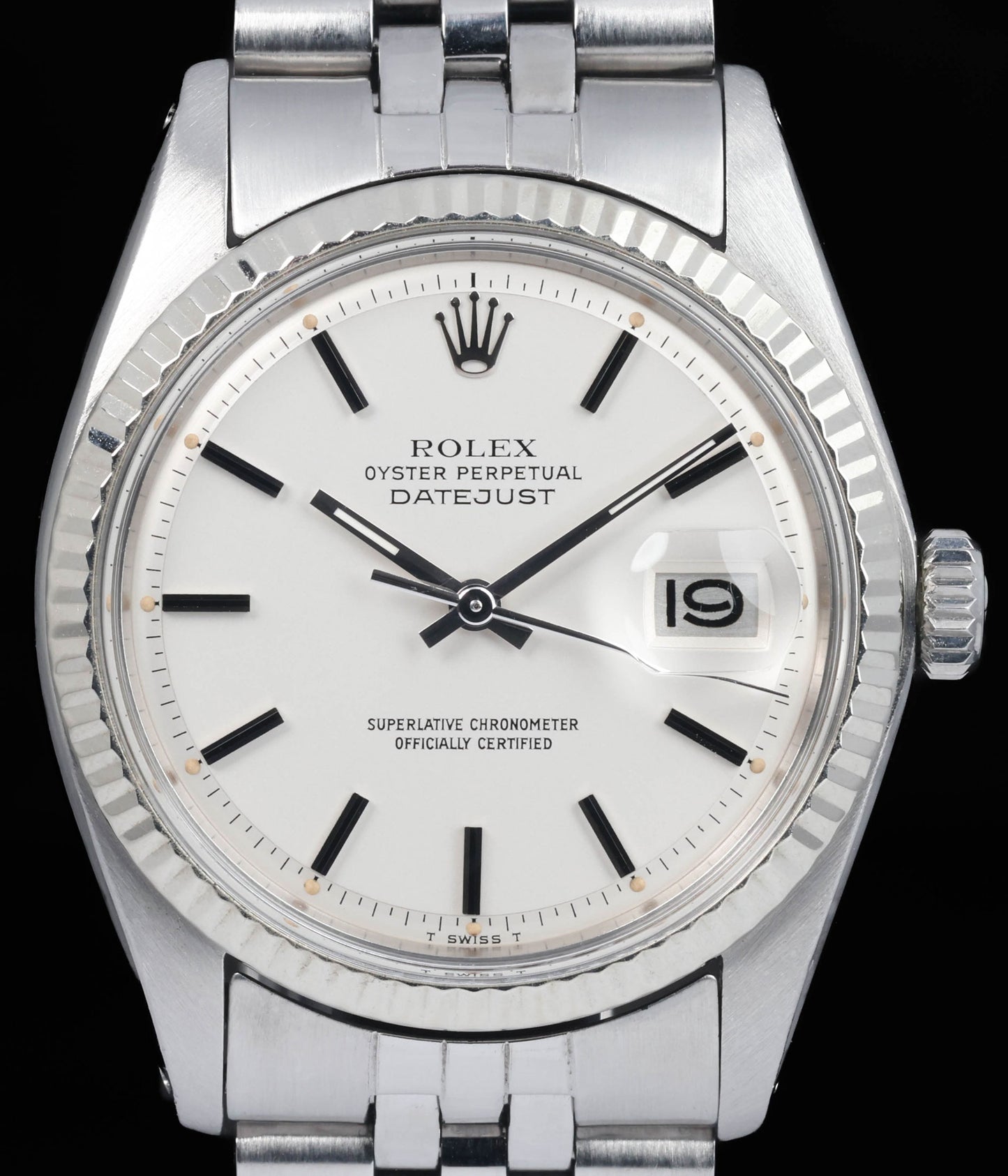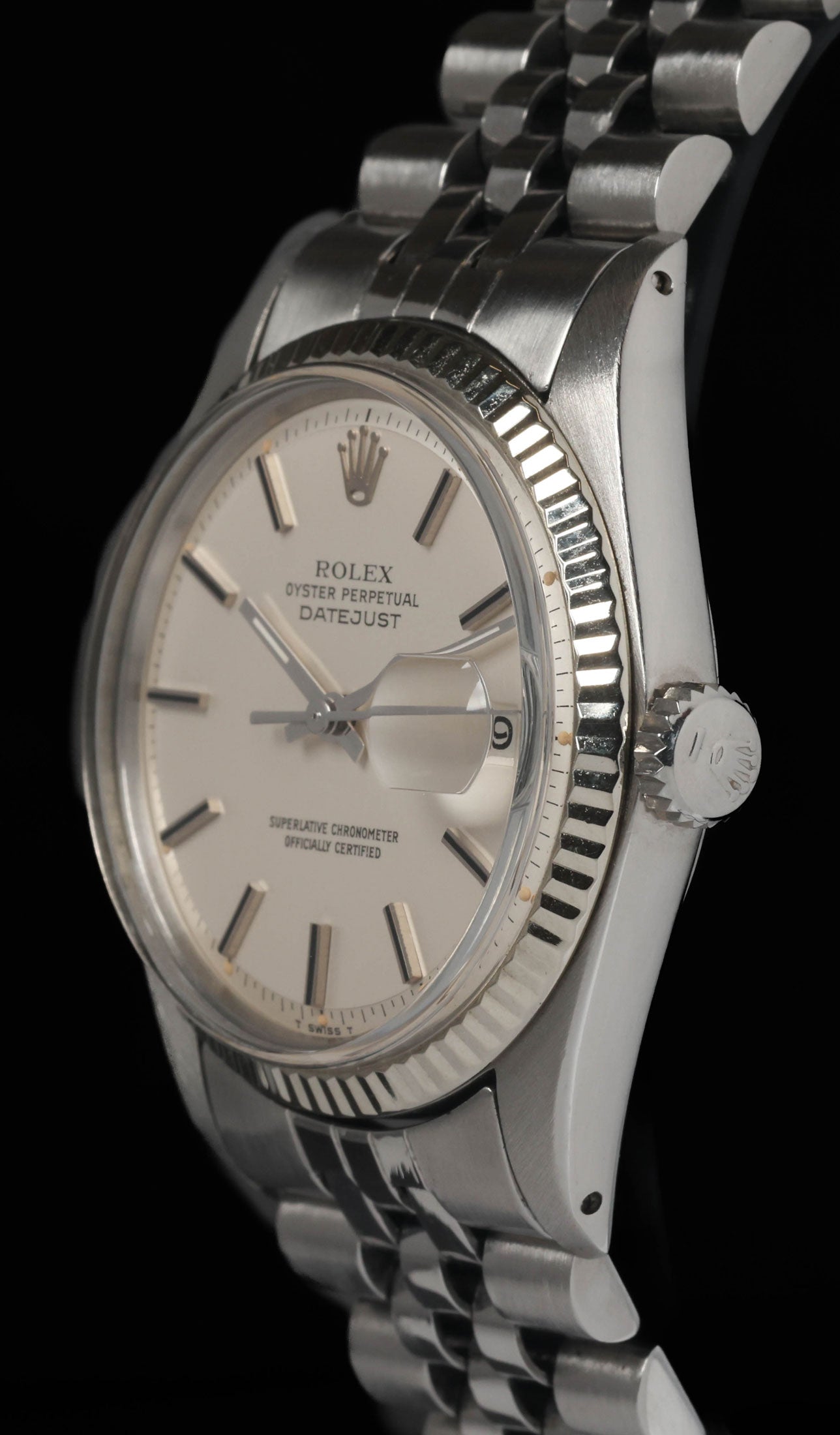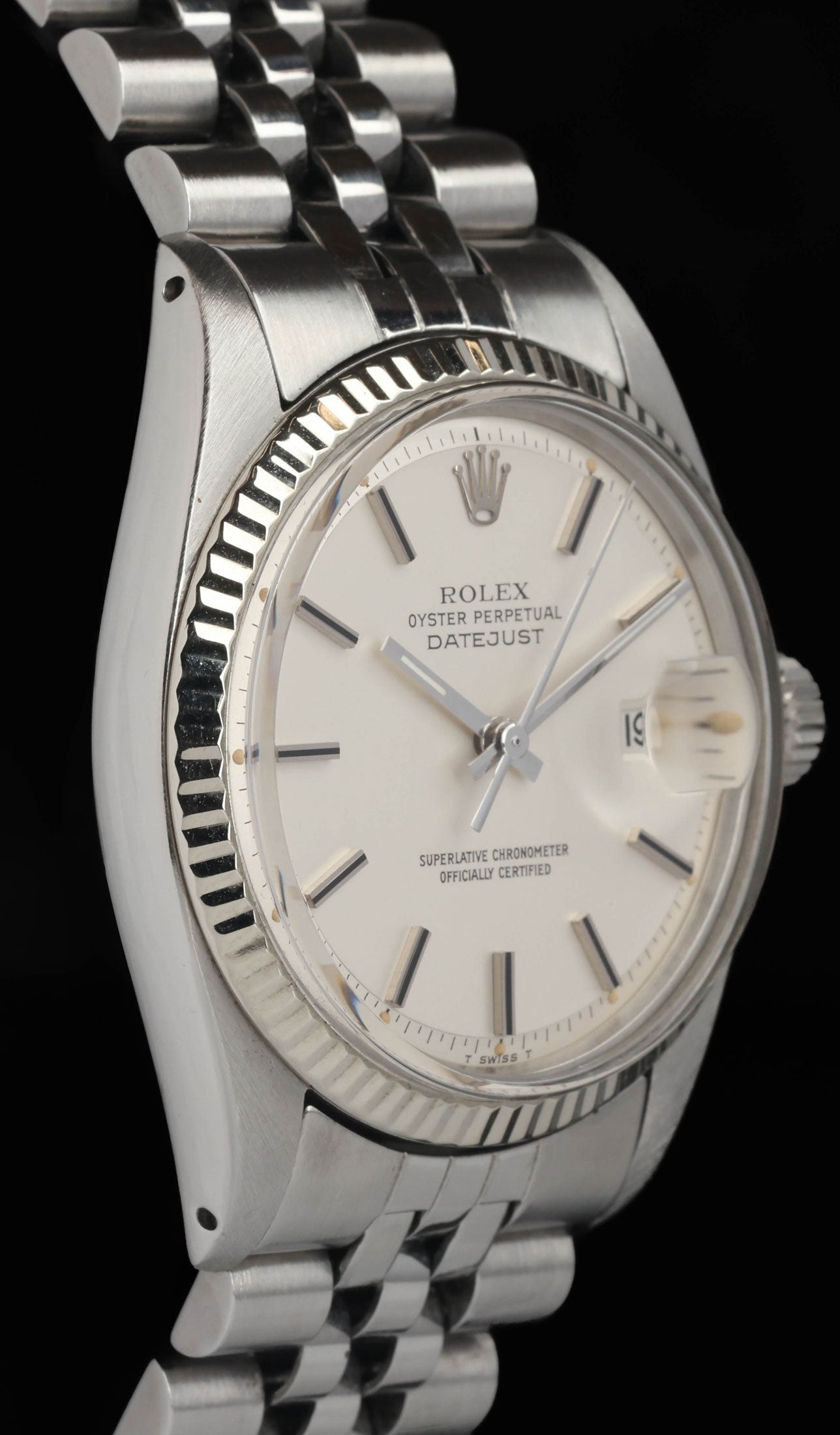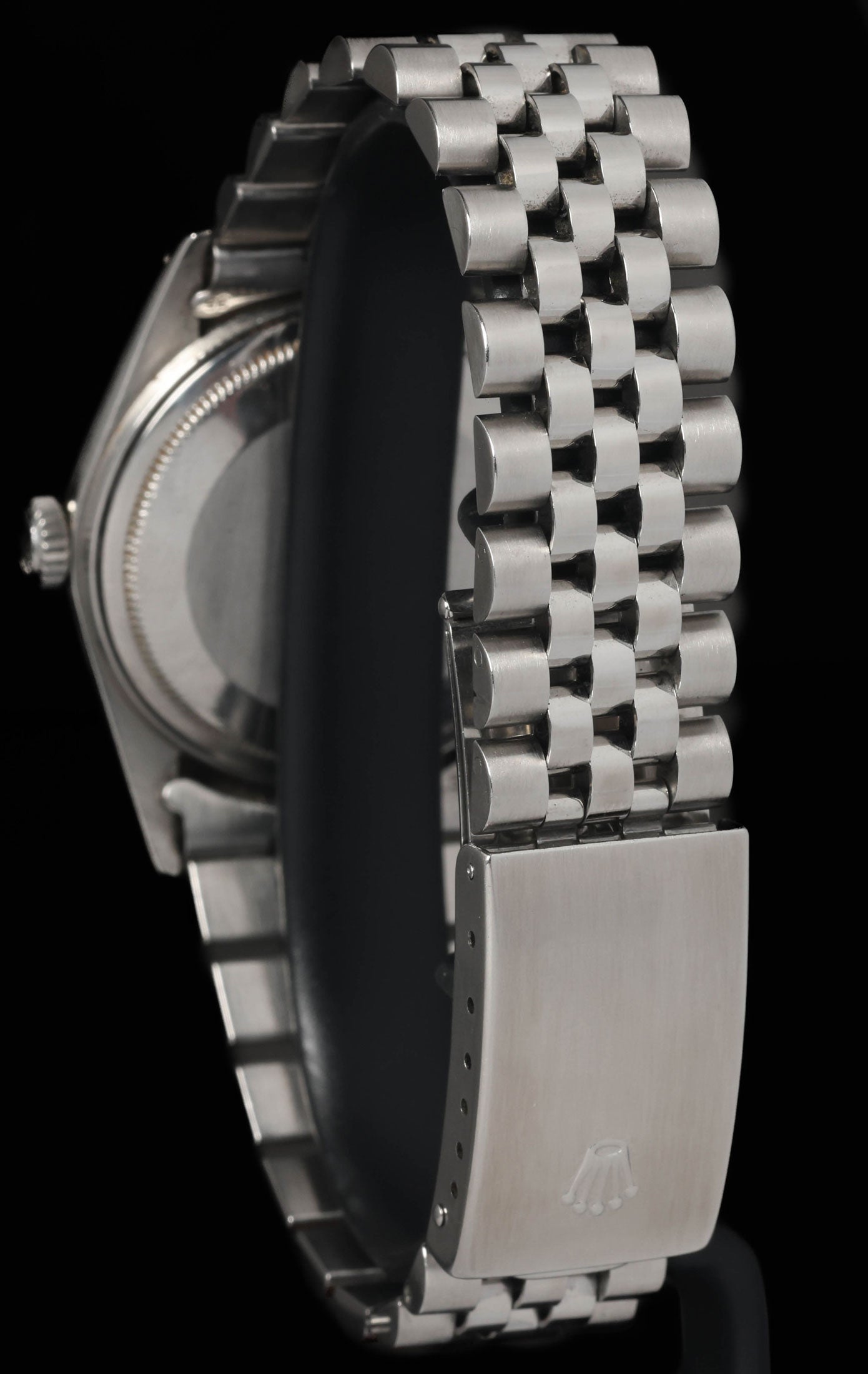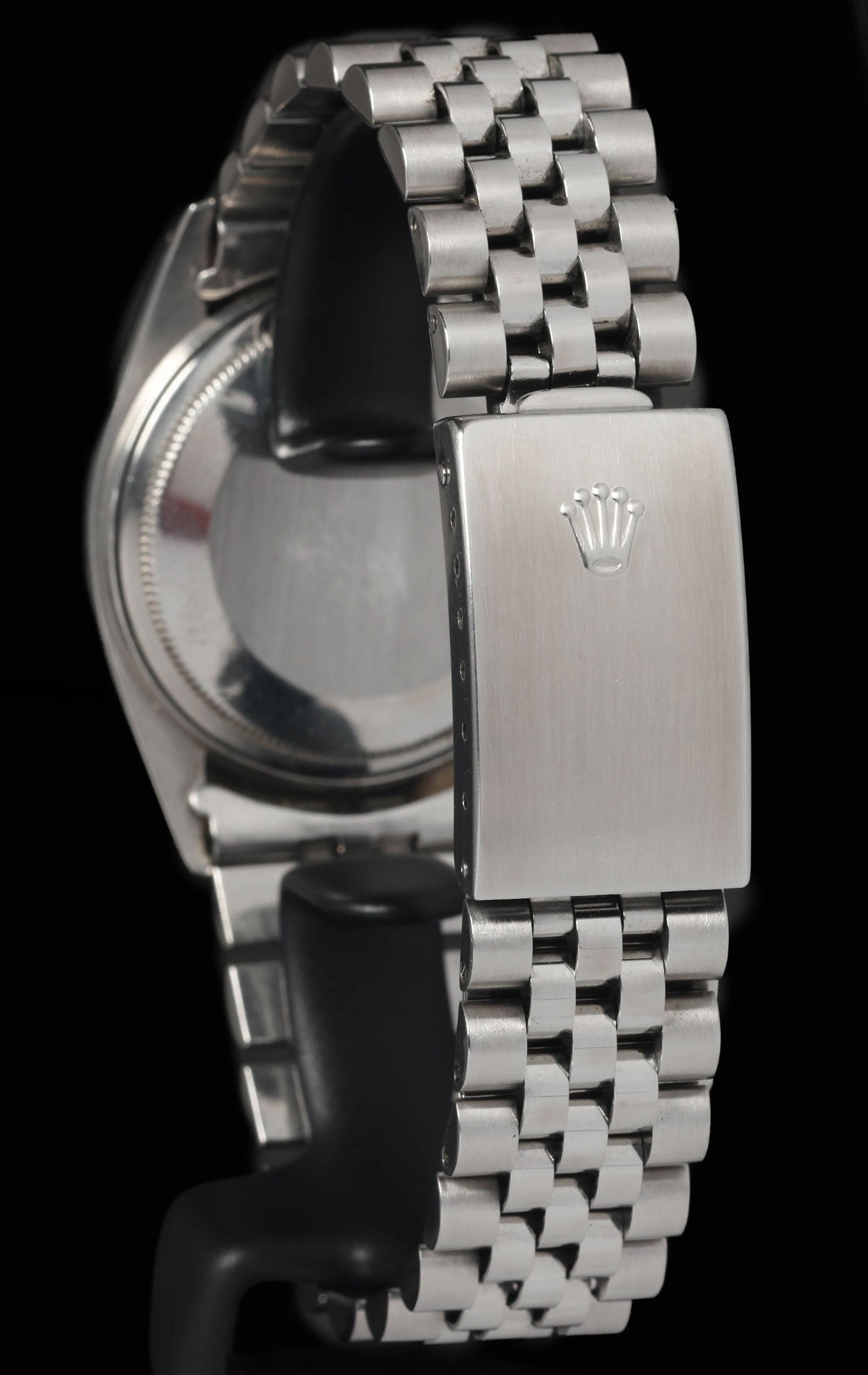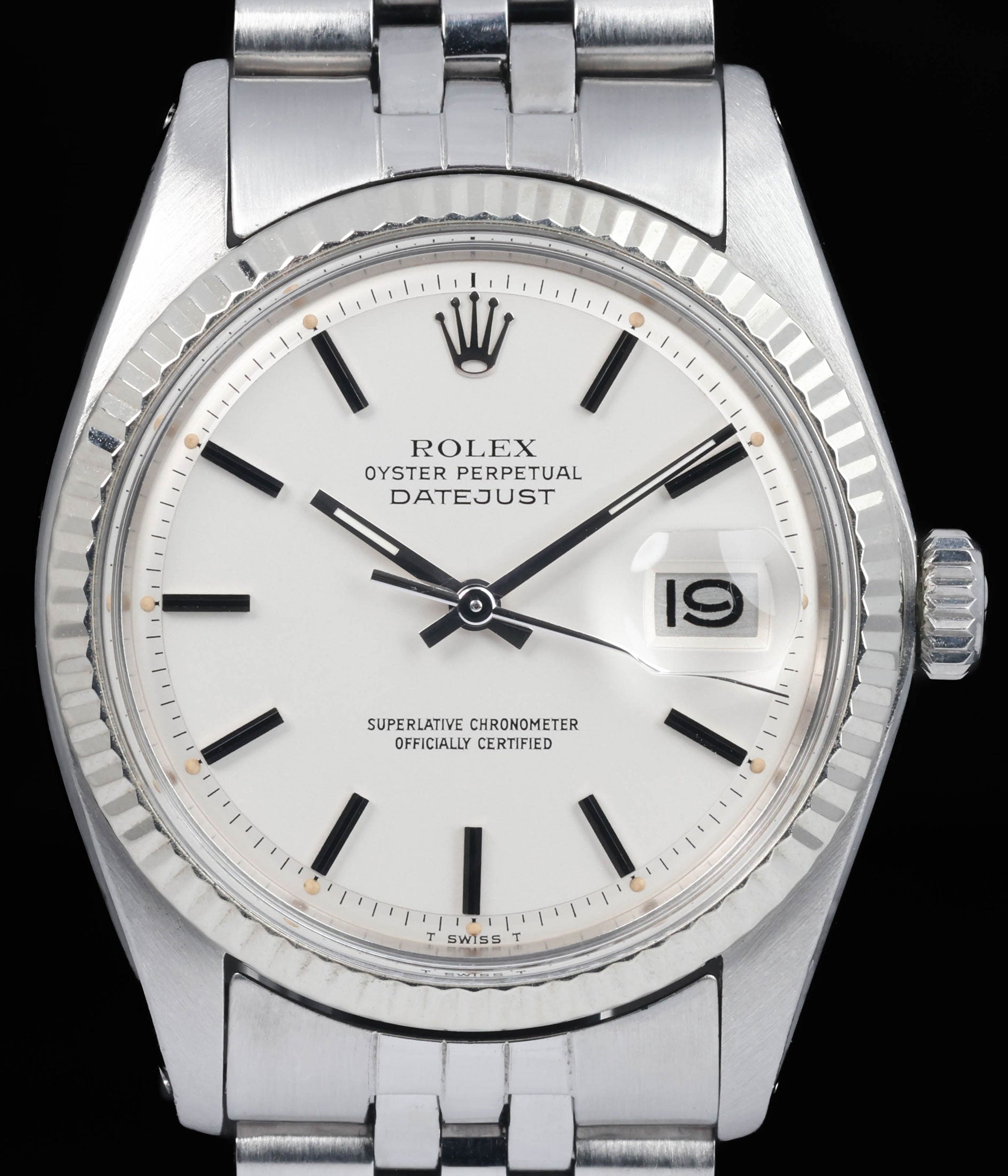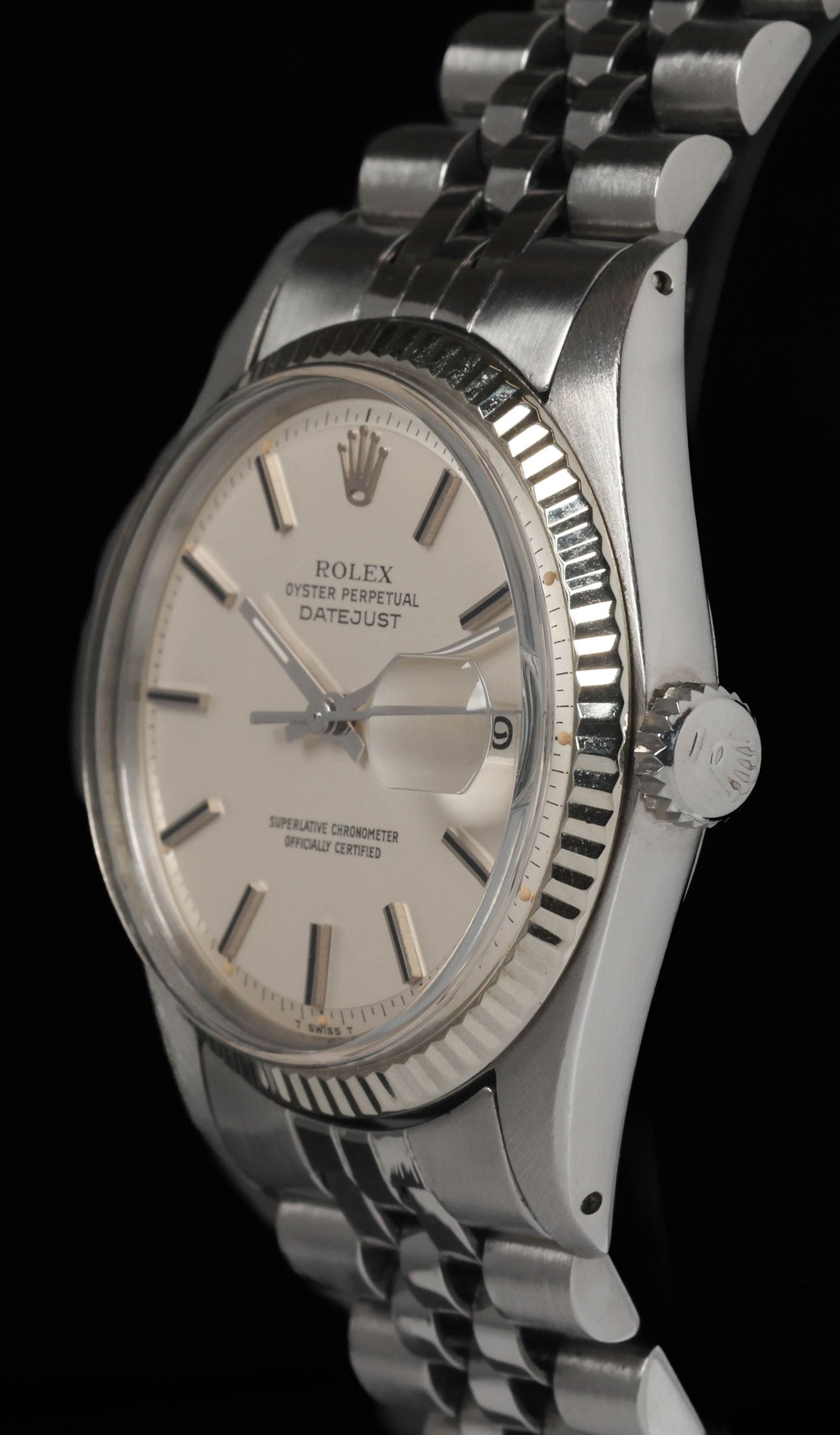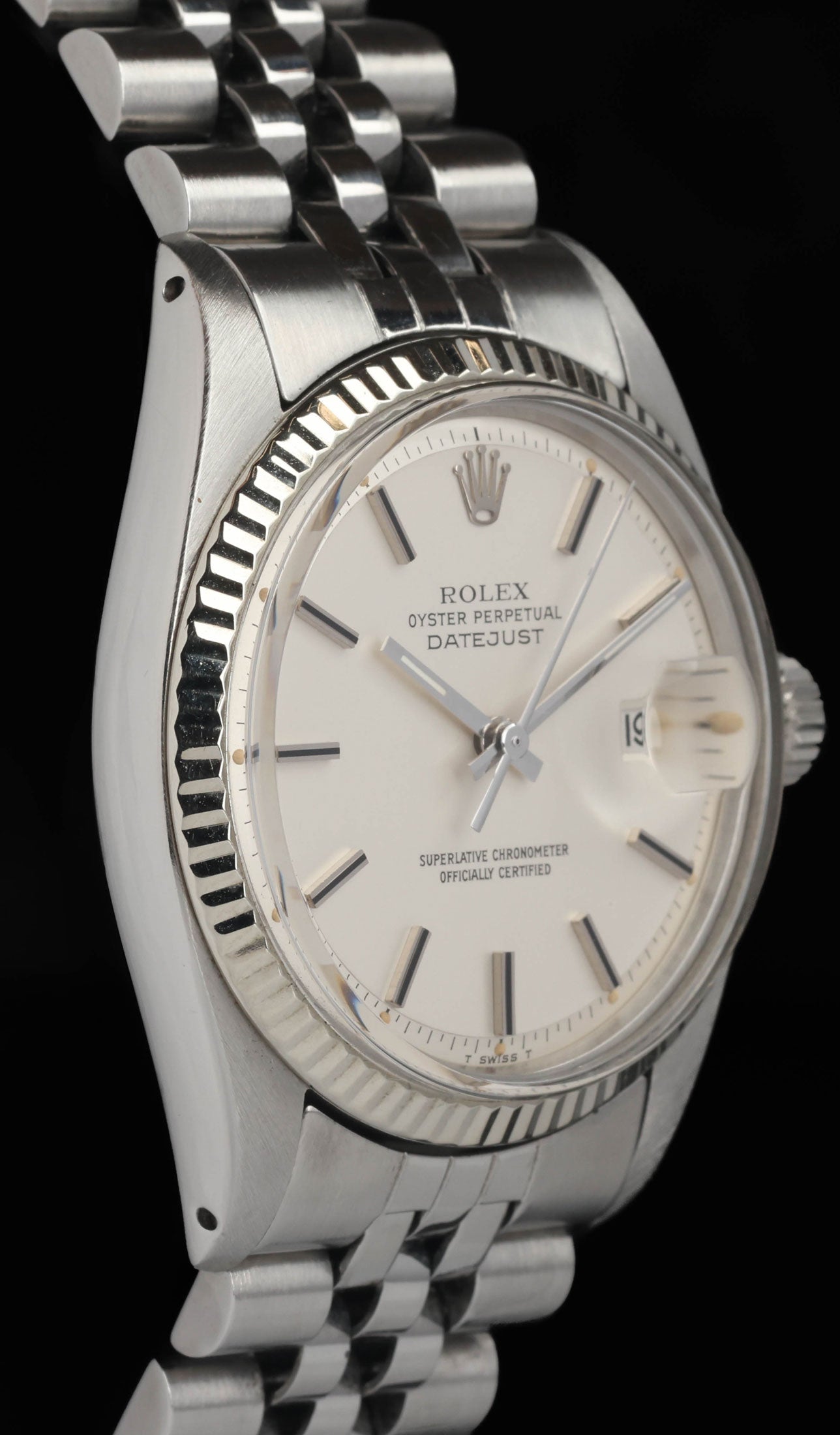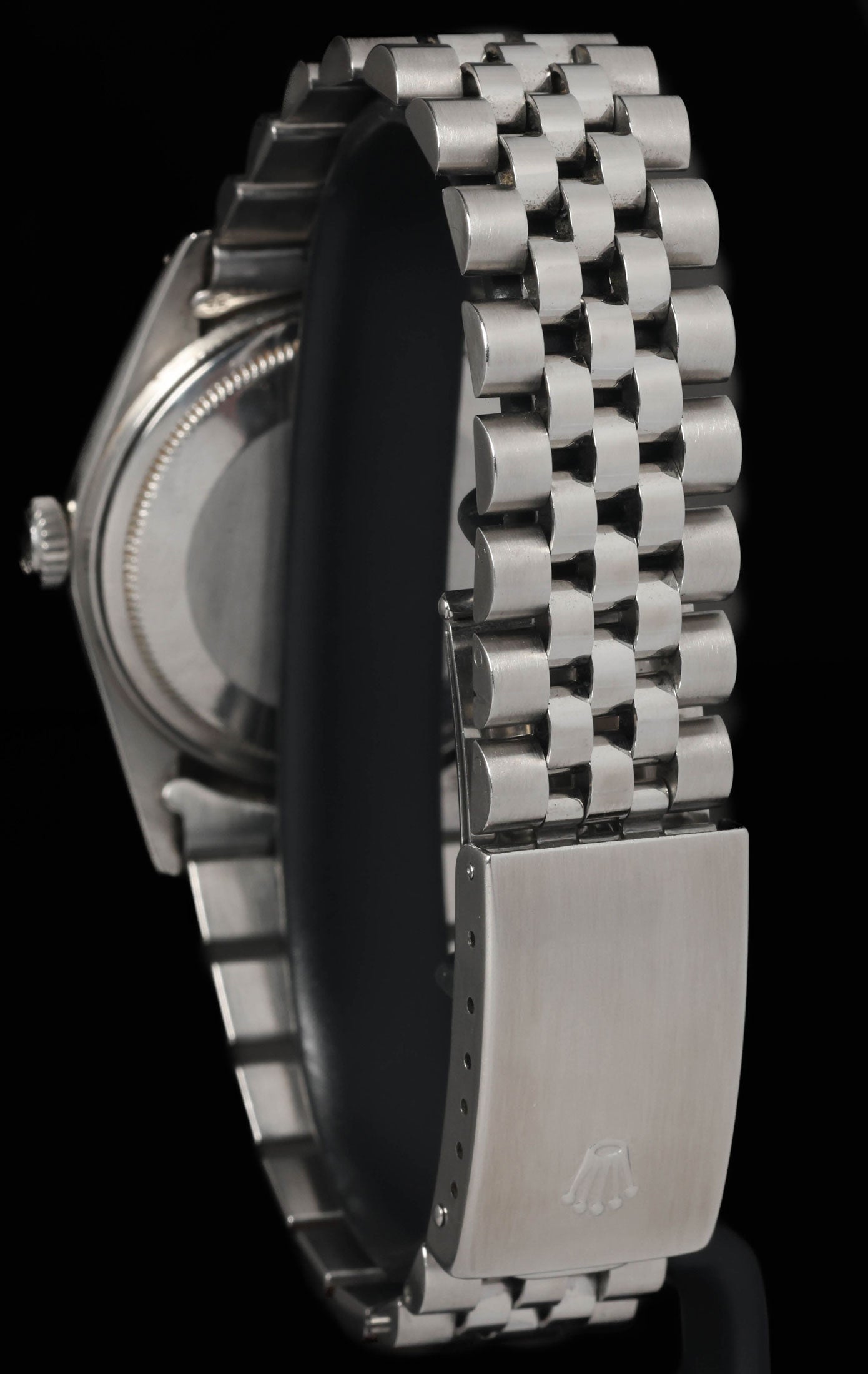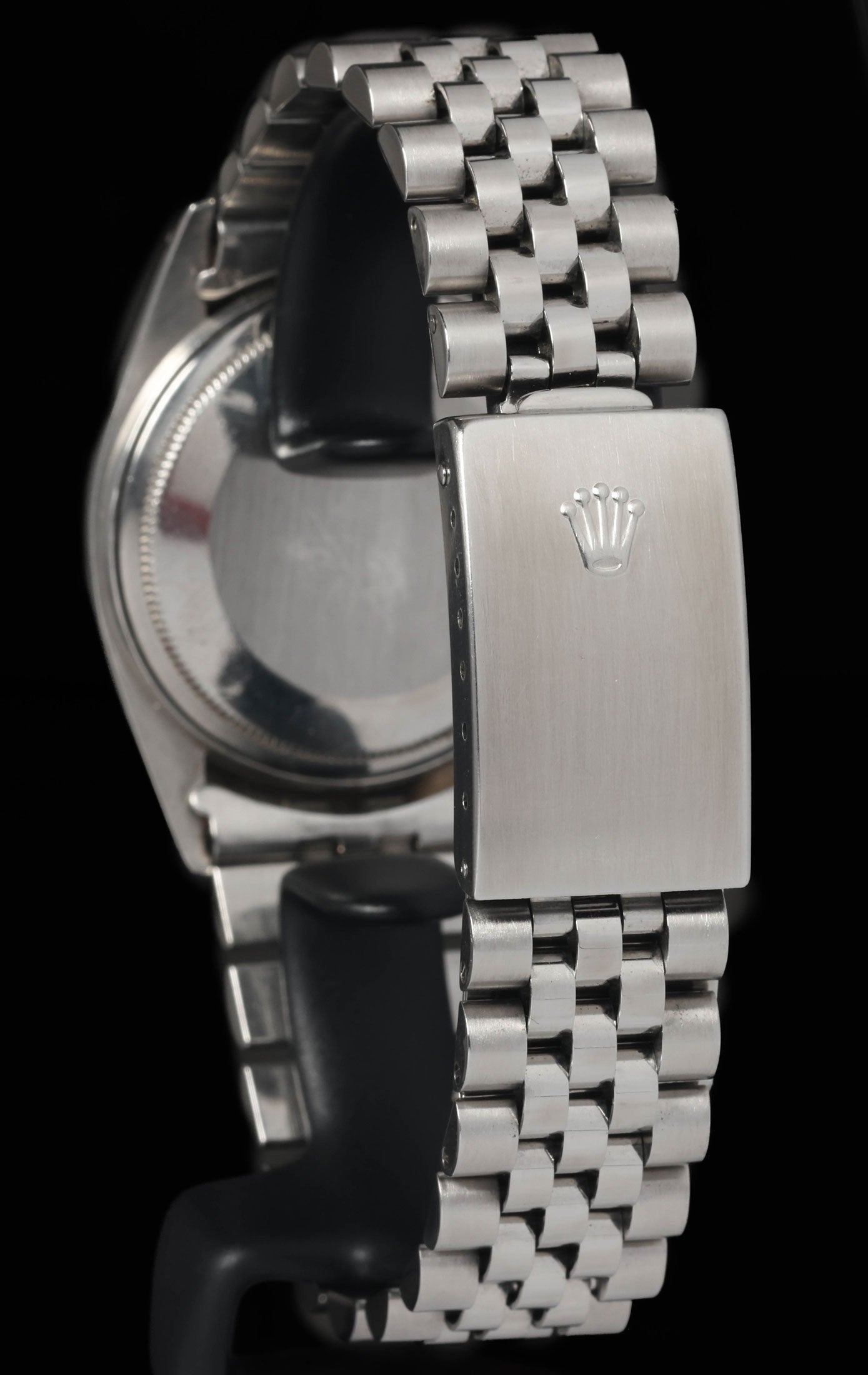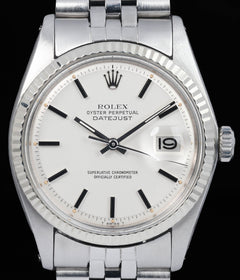Crown Vintage
Rolex Datejust 1601 'Pie Pan' 36mm 1976
Rolex Datejust 1601 'Pie Pan' 36mm 1976
Couldn't load pickup availability
Rolex Datejust 1601 'Pie Pan' 36mm 1976
The case is in very good condition, showing only light hairlines consistent with careful wear. It retains strong edges and appears unpolished, preserving its original factory profile.
The bracelet is also in very good condition, with little to no stretch, remaining tight and well-fitted to the case.
The dial presents in very good form, with all text crisp and clear. The hour markers display a warm, even patina that pairs beautifully with the original hands, which remain in excellent condition and match the tone of the lume consistently.
Overall, this is a well-preserved 1976 Datejust 1601, offering strong vintage appeal through its unpolished case, clean bracelet, and attractively aged dial and hands.
Share
Why we love this watch
Why we love this watch
Rolex Datejust 1601 ‘Pie Pan’ 36mm from 1976
The Rolex Datejust has long been one of the most recognisable watches in the world. Introduced in 1945 to mark the brand’s 40th anniversary, it brought with it a technical innovation that defined its name: the instantaneous change of the date at midnight. Over decades, Rolex refined the model into a staple of everyday elegance, offering durability and precision alongside restrained style. By the mid-1970s, the Datejust 1601 sat at the centre of this lineage. The 36mm reference balanced Rolex’s classic design codes with mechanical reliability, and when configured with the “pie pan” dial, it carried subtle depth and vintage charm that today makes it one of the most collectible expressions of the Datejust.
The 1601 reference had already been in production for more than a decade by 1976, having been introduced in the early 1960s. It was part of the second major generation of Datejusts, evolving from earlier references such as the 1603 and the early steel Datejusts with reference 6605. The 1601 retained the 36mm Oyster case, acrylic crystal, and the instantly recognisable date window at three o’clock beneath a magnifying cyclops lens, but distinguished itself with its fluted bezel and range of dials. This combination made it a versatile watch that could be worn as easily with a suit as with casual attire, something that explains its enduring popularity across generations.
Case and Bezel
In 1976, Rolex was already well established as a manufacturer of tool watches, with Submariners, GMT-Masters, and Explorers defining its reputation for toughness. But the Datejust demonstrated that the Oyster case could be as refined as it was functional. Water resistance, shock protection, and a screw-down crown were features not typically associated with dress watches of the era, but Rolex combined them with a slim profile and understated proportions.
The 1601 is most closely associated with its fluted bezel. On examples produced in stainless steel with white gold bezels, the fluting added a visual sharpness that played with light, giving the watch a sense of refinement without ostentation. Over time, the fluted bezel became a hallmark of the Datejust line, instantly identifiable and often imitated. Collectors today prize bezels that have retained their sharpness, as polishing over the decades tends to soften the fluting.
The Pie Pan Dial
One of the most charming features of the 1601 from this period is the pie pan dial. The term refers to the way the outer edge of the dial slopes downwards, creating a subtle dish shape reminiscent of an inverted pie pan. This detail not only adds depth and dimension to the dial but also enhances the interplay of light across its surface.
By 1976, Rolex offered pie pan dials in a variety of finishes—silver sunburst, champagne, blue, and darker tones. Hour markers ranged from simple stick batons to applied indices with luminous plots. Some examples carried Roman numerals or more decorative details, though the clean stick-marker versions remain the most emblematic of the era. Tritium was used for luminescence, with small plots adjacent to the hour markers and luminous inserts in the hands, both of which have often aged to warm creamy tones today.
The date window at three o’clock, with its quick-change mechanism, was framed by the cyclops lens on the acrylic crystal. The clarity of the cyclops, often a point of discussion among enthusiasts, added both legibility and distinctiveness.
The pie pan design was gradually phased out in the late 1970s and early 1980s, replaced by flat dials as Rolex moved into the reference 16014 and later sapphire crystal generations. As such, pie pan dials serve as a clear marker of vintage Datejusts, distinguishing them from their modern counterparts and contributing significantly to their appeal.
Movement: Calibre 1570
At the heart of the 1601 was Rolex’s calibre 1570, one of the brand’s most respected automatic movements. Introduced in the mid-1960s, it was a workhorse calibre used across many Rolex models, including the Submariner, GMT-Master, and Explorer. Known for its reliability, durability, and accuracy, the 1570 featured a frequency of 19,800 vibrations per hour, later upgraded to 21,600, and offered hacking seconds—where the seconds hand stopped when the crown was pulled out, allowing precise time-setting.
The calibre 1570 was chronometer certified, a point Rolex highlighted on the dial with the familiar “Superlative Chronometer Officially Certified” text. Serviced examples remain highly reliable today, a testament to Rolex’s engineering. For collectors, the presence of an original calibre 1570 in clean condition underlines the authenticity and longevity of the watch.
Bracelet Options
In 1976, the Datejust 1601 could be fitted with either the Jubilee or Oyster bracelet. The Jubilee, introduced alongside the Datejust in 1945, was the more closely associated option, with its five-link design offering comfort and a dressier appearance. Constructed in stainless steel with folded links during the period, the Jubilee bracelet aged with a certain stretch over time, now familiar to vintage collectors.
The Oyster bracelet, by contrast, lent the Datejust a slightly sportier and more versatile character. Its three-link construction provided robustness, though in this period the links were also hollow. Both options featured folding clasps and endlinks specific to the 1601 case, stamped with reference numbers that aid in verifying originality.
The Datejust in the 1970s
By the mid-1970s, Rolex had become one of the most globally recognised watch brands, and the Datejust was at the core of its appeal. It was marketed not as a specialist tool watch, but as the everyday luxury watch—capable of crossing contexts. Celebrities, business leaders, and political figures wore Datejusts, and the model was a frequent sight in advertising and popular culture.
At the same time, the Swiss watch industry faced growing pressure from quartz technology, with brands launching electronic watches in an effort to remain competitive. Rolex did experiment with quartz, introducing the Oysterquartz Datejust in 1977, but the mechanical 1601 remained in full production and continued to sell strongly. Its enduring success through the quartz crisis highlighted the appeal of Rolex’s approach: offering timeless design, technical reliability, and understated luxury rather than chasing fleeting trends.
1976 as a Year of Production
Dating a vintage Rolex to a specific year often relies on serial numbers. By 1976, Rolex serials fell in the 4.0 to 4.2 million range. Watches from this year reflect the maturity of the 1601 reference, produced during a period when Rolex had perfected its manufacturing consistency. The mid-1970s examples often display excellent finishing, strong case construction, and dials with tritium lume that has now aged attractively.
This was also a period when Rolex had solidified its global distribution. A Datejust 1601 purchased in 1976 could have come from an authorised dealer in New York, London, Tokyo, or Sydney, reflecting Rolex’s international reach. It is not uncommon to find examples with original papers stamped by jewellers across continents, a reminder of the Datejust’s role as a global watch.
Final Thoughts
The Rolex Datejust 1601 from 1976, particularly with the pie pan dial, is a classic vintage watch that embodies Rolex’s mid-century design at its peak. It balances elegance with practicality, powered by one of the brand’s most dependable movements, and enclosed in a case that remains timeless nearly fifty years later.
Its pie pan dial gives it depth and character no longer found in later flat-dial versions, while its fluted bezel and 36mm proportions place it squarely in the lineage of the Datejust as we know it today. For collectors, it offers a way to experience vintage Rolex without the premiums attached to sports models, while still carrying the full weight of the brand’s history and identity.
More than that, the 1601 tells the story of a time when Rolex was navigating both its growing global prestige and the challenges of the quartz revolution, yet continued to produce mechanical watches that remain highly prized today. The 1976 Datejust 1601 ‘Pie Pan’ stands as a reminder of Rolex’s ability to craft watches that transcend eras—practical in their day, and timeless half a century later.
Case & Bracelet
Case & Bracelet
Very good condition with light hairlines visible. Case looks to be unpolished. Bracelet in very good condition with little to no stretch.
Dial & Hands
Dial & Hands
Very good condition with warm even patina on hour markers.
Warranty & Condition
Warranty & Condition
Crown Vintage Watches provides a minimum 3-month mechanical warranty on pre-owned watches, from the date of purchase.
The warranty covers mechanical defects only.
The warranty does not cover damages such as scratches, finish, crystals, glass, straps (leather, fabric or rubber damage due to wear and tear), damage resulting from wear under conditions exceeding the watch manufacturer’s water resistance limitations, and damage due to physical and or accidental abuse.
Please note, water resistance is neither tested nor guaranteed.
Shipping and insurance costs for warranty returns to us must be covered by the customer. Returns must be shipped via traceable courier. Return shipment must be pre-paid and fully insured. Collect shipping will be refused. In case of loss or damages, the customer is liable.
Our Pledge
At Crown Vintage Watches, we stand by the authenticity of every product we sell. For added peace of mind, customers are welcome to have items independently authenticated at their own expense.
Condition
Due to the nature of vintage timepieces, all watches are sold as is. We will accurately describe the current condition and working order of all watches we sell to the best of our ability.
Shipping & Refund
Shipping & Refund
